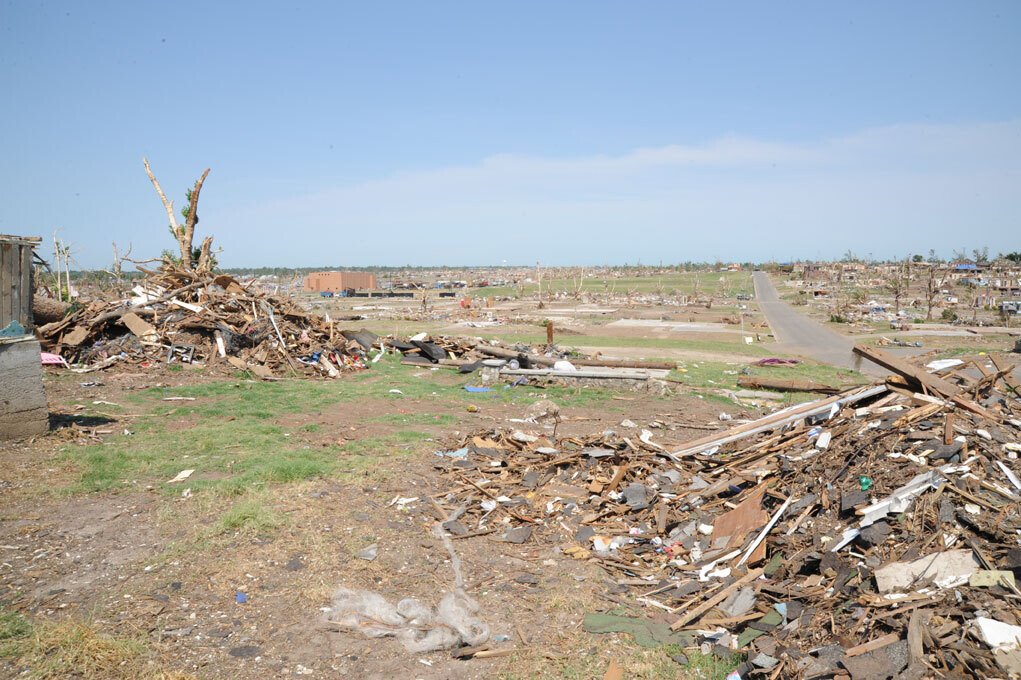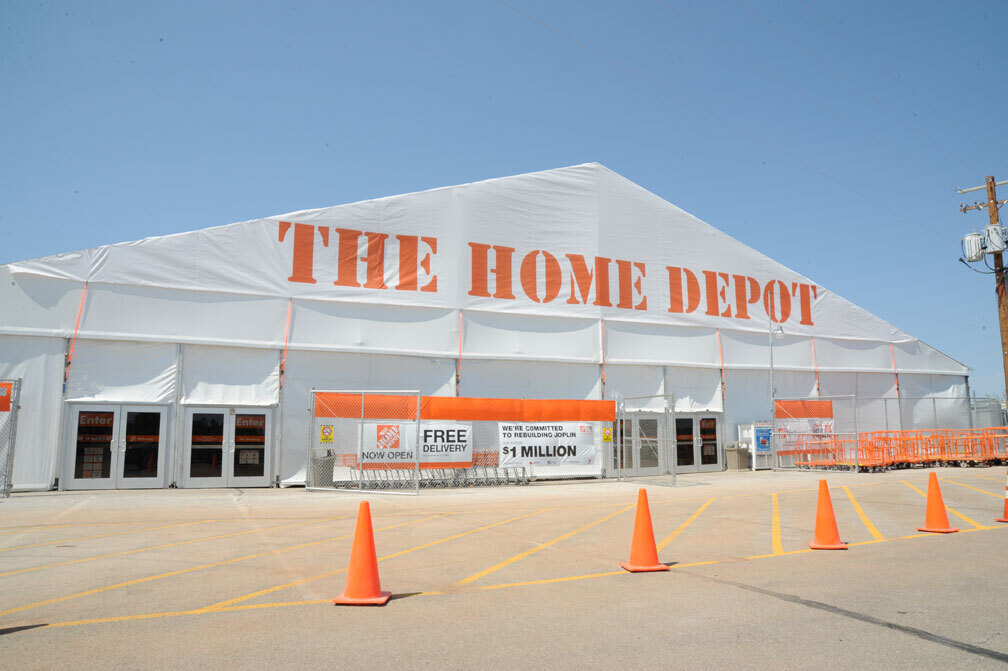Joplin’s Home Depot in the Eye of the Storm

ON MAY 22, 2011, A F-5 tornado hit Joplin, Missouri, gouging a half mile wide, 7 mile long belt of utter destruction through town. Everything in this routed out swath was ripped up and blown away. 7,000 homes were destroyed, 18,000 cars were flung around, 500 commercial buildings were demolished. Telephone poles were snapped off. And 162 people were killed. This was the worst tornado strike in the USA since 1947, and the most expensive so far (17,000 insurance claims and $3 billion in damages).
 It was a Sunday afternoon. More than half of the deaths were people at home. 14% were in cars. And a lot of people were out shopping with their families. The tornado went from west to east, carving a cross section through this community of 50,000. It landed first in the rural outskirts, then through the increasing density of developed housing blocks, crossing South Main Street a mile south of downtown. Then it crossed the main commercial strip, Range Line Road, a mile north of Exit 8 of the interstate, with Golden Corral Buffet, KFC, Taco Hut, Red Wing Shoes, and Walmart Supercenter number 59, then through a industrial/warehouse area, the eastern residential outskirts, then crossed Interstate 44, and disappeared back up into the sky.
It was a Sunday afternoon. More than half of the deaths were people at home. 14% were in cars. And a lot of people were out shopping with their families. The tornado went from west to east, carving a cross section through this community of 50,000. It landed first in the rural outskirts, then through the increasing density of developed housing blocks, crossing South Main Street a mile south of downtown. Then it crossed the main commercial strip, Range Line Road, a mile north of Exit 8 of the interstate, with Golden Corral Buffet, KFC, Taco Hut, Red Wing Shoes, and Walmart Supercenter number 59, then through a industrial/warehouse area, the eastern residential outskirts, then crossed Interstate 44, and disappeared back up into the sky.
 203 people were in the Walmart when the tornado hit the cinderblock big box. 200 of them survived. Across 20th Street, at the Home Depot, 29 customers and employees were amidst the canyon-like aisles of the warehouse retail store. When the tornado appeared, employees directed everyone to the break area room at the back of the store, and locked the doors so they would not blow open. Through the glass doors, an employee saw several people trying to get in from the parking lot. He let them in, but none of them made it to the safety of the back of the store.
203 people were in the Walmart when the tornado hit the cinderblock big box. 200 of them survived. Across 20th Street, at the Home Depot, 29 customers and employees were amidst the canyon-like aisles of the warehouse retail store. When the tornado appeared, employees directed everyone to the break area room at the back of the store, and locked the doors so they would not blow open. Through the glass doors, an employee saw several people trying to get in from the parking lot. He let them in, but none of them made it to the safety of the back of the store.
The wind ripped the roof of the Home Depot off, and the unsupported tilt-up concrete walls toppled over like dominos. It was over in less than 90 seconds. The 28 survivors in the back were lucky that the wall next to them fell outwards, away from them, though some were saved from collapsing walls only by the happenstance of a sturdy desk.
Building codes in most of the tornado prone parts of the country require commercial structures to withstand up to 90 mph winds. An F5 tornado like this one has winds around 225 mph. The tilt up method of construction, where walls are slabs of concrete, poured flat on site, tilted up vertically, then secured primarily by connecting them to the lightweight metal roof is a common and cost-effective method for making big box buildings.
Hundreds of Home Depot stores like this one, as well as those of other retailers and warehouses, are built this way. With block construction, which is more common, when walls fail they break apart, rather than fall as a continuous slab, causing less collapse and damage. Such was the case at the Walmart across the street.
Joplin’s Home Depot began selling lumber, roofing material, and whatever it could get, out of its parking lot, soon after the tornado, supplying much-needed building materials for repairing and rebuilding Joplin (Lowes, less than half a mile down the street, but barely damaged, was open the day after the storm).
In less than a month, Home Depot opened a 60,000 square foot temporary store in a tent-like structure in the parking lot in front of the remains of the old store, while a new Home Depot building, with slab wall construction, is being built on the old site. It will be the first Home Depot to have a storm shelter, even though local codes don’t require it. It has been said that there is no such thing as a natural disaster, since tornados, floods, and earthquakes are natural occurrences, whose effects, disastrous or otherwise, are on the buildings, structures, and people that we place, unnaturally, in their path. Terrestrial attacks, like what happened in Joplin, where, in even the less demolished areas, trees are debarked before they are snapped off at their bases or uprooted, test this otherwise sensible notion. They demand that we rethink how far we should go to limit the disaster. While we are not in complete control of the weather yet, nor shall we be for some time, we are, currently, entirely in control of mediating it’s effects. ♦
It has been said that there is no such thing as a natural disaster, since tornados, floods, and earthquakes are natural occurrences, whose effects, disastrous or otherwise, are on the buildings, structures, and people that we place, unnaturally, in their path. Terrestrial attacks, like what happened in Joplin, where, in even the less demolished areas, trees are debarked before they are snapped off at their bases or uprooted, test this otherwise sensible notion. They demand that we rethink how far we should go to limit the disaster. While we are not in complete control of the weather yet, nor shall we be for some time, we are, currently, entirely in control of mediating it’s effects. ♦
